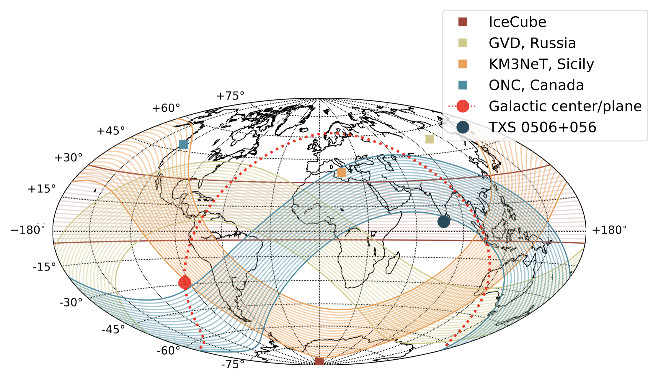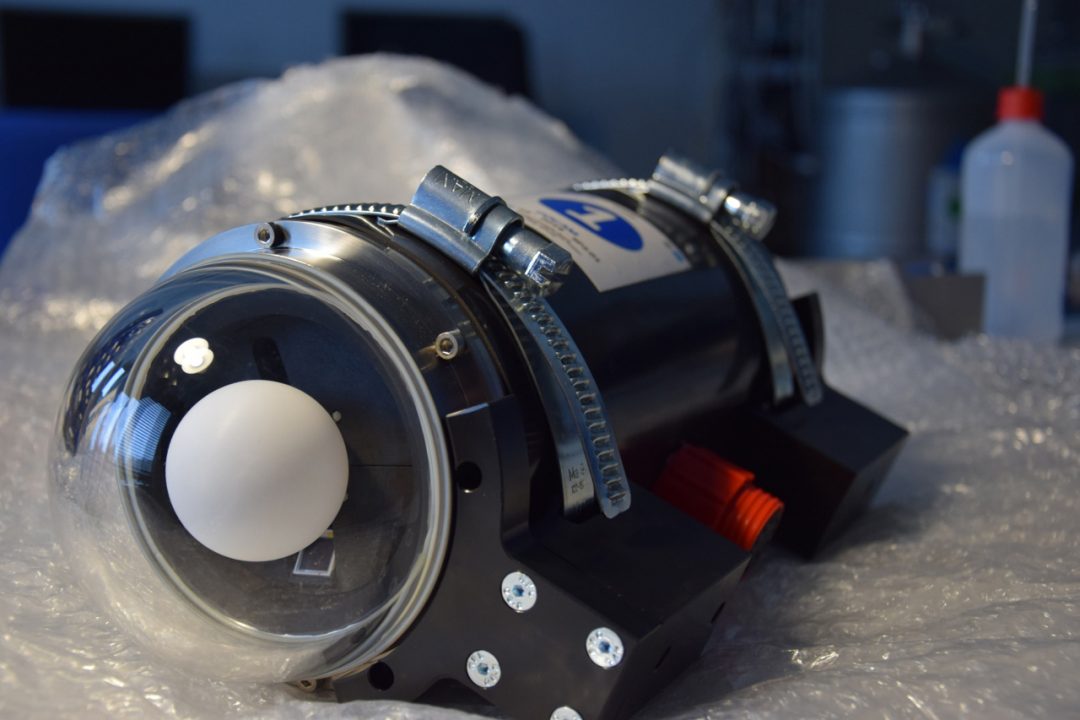News & Events
August 11, 2020
With proper investment, the pacific ocean is ready for (neutrino) business.
For the last fifty years, researchers have been trying to establish detectors in the pacific ocean, but saltwater has always been an issue. While ideas from 50 years ago still stand, technology such as connections, enclosures and cables were not available to the same degree as they are now. Nowadays, the equipment is more readily available.

Design of the proposed final stage of instrumentation of the Pacific Ocean Neutrino Experiment consisting of seven segments optimized for energies above 50 TeV (left) and the design of an individual segment that is planned to be installed in a four weeks sea operation in 2023/24 as Pacific Ocean Neutrino Explorer standalone detector. (Credit: TUM)
The P-ONE team is searching for rare, high-energy neutrinos, which arrive at earth infrequently. At its current iteration, P-ONE sensitivity is too low to contribute meaningfully to the broader high-energy neutrino research community. However, by constructing the full experimental, it will provide the cheapest way to extend detection capability while adding an ideal location to the global network of detectors. Experiments such as IceCube will be augmented, allowing them additional coverage of the Northern Hemisphere. “The perfect distribution of large-scale detectors to get a global coverage would be a detector in the Mediterranean, a detector in Lake Baikal, in Siberia and having a detector in the pacific,” says Carsten Krauss, (University of Alberta), an experimental physicist on the P-ONE project. This global coverage of detectors is ultimately the long-term goal P-ONE is working towards.

Neutrino telescopes, existing and under construction, around the globe with their horizontal coverage from which high energy neutrinos will not be affected by the Earth absorption. (Credit: M. Huber/TUM)
High-energy neutrinos (HENs) are unlike the typical neutrino discussed by the Astrophysics community. They occur infrequently and are thought to have energies above 100 TeV (1014 electron volts, over 1000 x higher energy than standard neutrinos). While the standard neutrino can pass through the planet, the cross-section for HEN is typically so large they are absorbed by the earth. If you want to spot one coming from a galactic nuclear event, you need to be able to detect it before the absorption. However, by looking directly skyward, you are subject to a high amount of background radiation that makes distinguishing the neutrinos impossible. As such, an ideal position is underground while looking sideways.
Canada’s pre-existing technology makes investing in this High Energy Neutrino research now, especially efficient. Through Ocean’s Network Canada (ONC), Canada has already invested in crucial infrastructure that the P-ONE experiment can build on. Further investment would continue to fund ONC’s underwater observatory. Changing the way we study the ocean, providing scientific evidence for policymakers, managing marine resources, and monitoring climate change issues are just a few tasks accomplished by the ONC. By utilizing the ONC research infrastructure, P-ONE has the opportunity to develop neutrino detection for minimal investment.

23/03/2018, Physics Department, Garching: A ready-labeled POCAM (Photo: TUM & Ocean Networks Canada)
P-ONE will benefit not only the Astrophysics community but also the field of Biology. Deep ocean biology is an expensive research process. Single measurements can be significant financial setbacks. By giving deep ocean biologists an opportunity to partner with P-ONE, they will have numerous instances to join the team in seeing deep into the ocean. This oceanic descent will benefit both oceanographic monitorings as well as allowing teams of biologists to study light omission patterns that will be recorded by the P-ONE experiment. Carsten Krauss explains how physicists will use these recordings to measure backgrounds and calibrate their detector, and how the teams of biologists accompanying them will capture “the pulse of the ocean at every single point in time.”
P-ONE already has some equipment that is running. The confidence to move forward with a larger project is supported by the setup of the pathfinder project established in the summer of 2018 called STRAW. The project has shown only success so far and is a critical step before additional investment. The concept began with the Dumont Detector in the 70s. However, due to technical limitations, teams that were using the right ideas were unable to pursue what today P-ONE can achieve. It is important to note that the efforts of the groups before P-ONE were instrumental in guiding the success that has been able to be made today.
